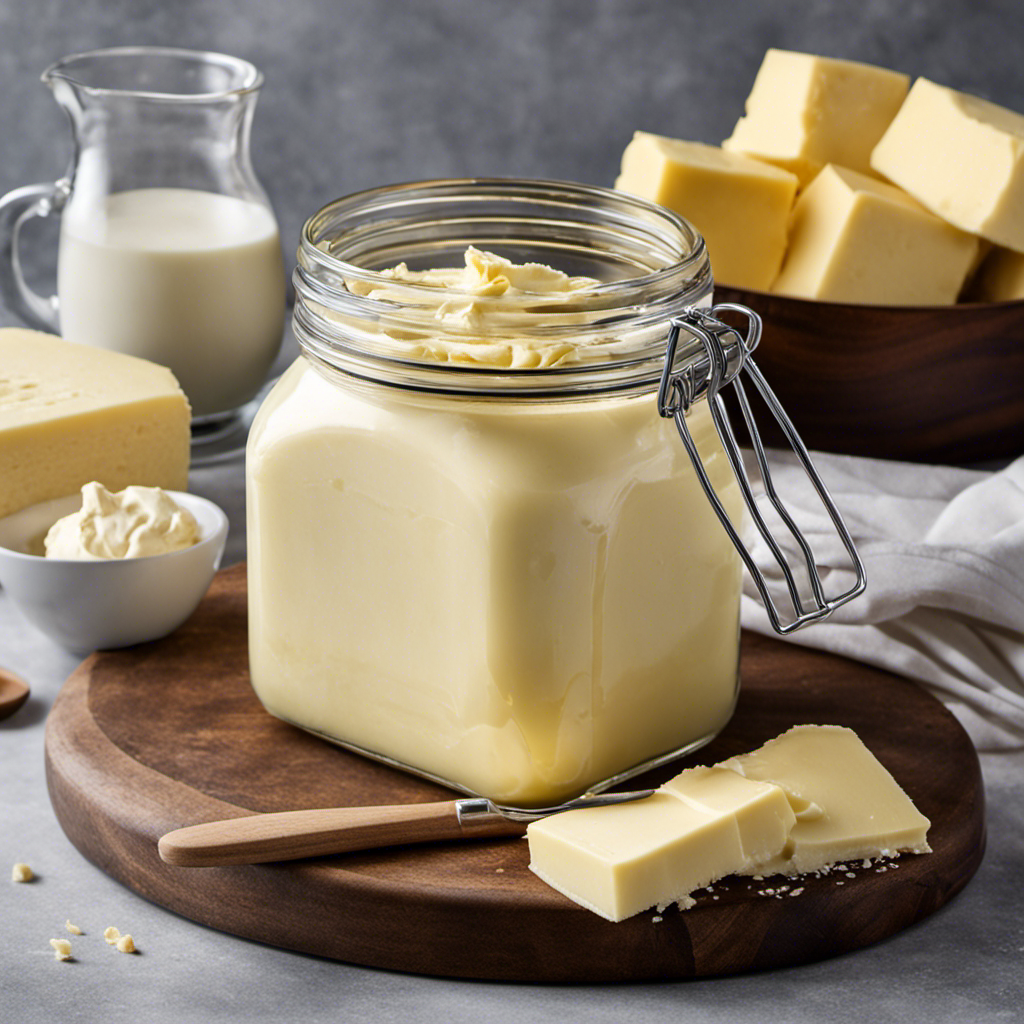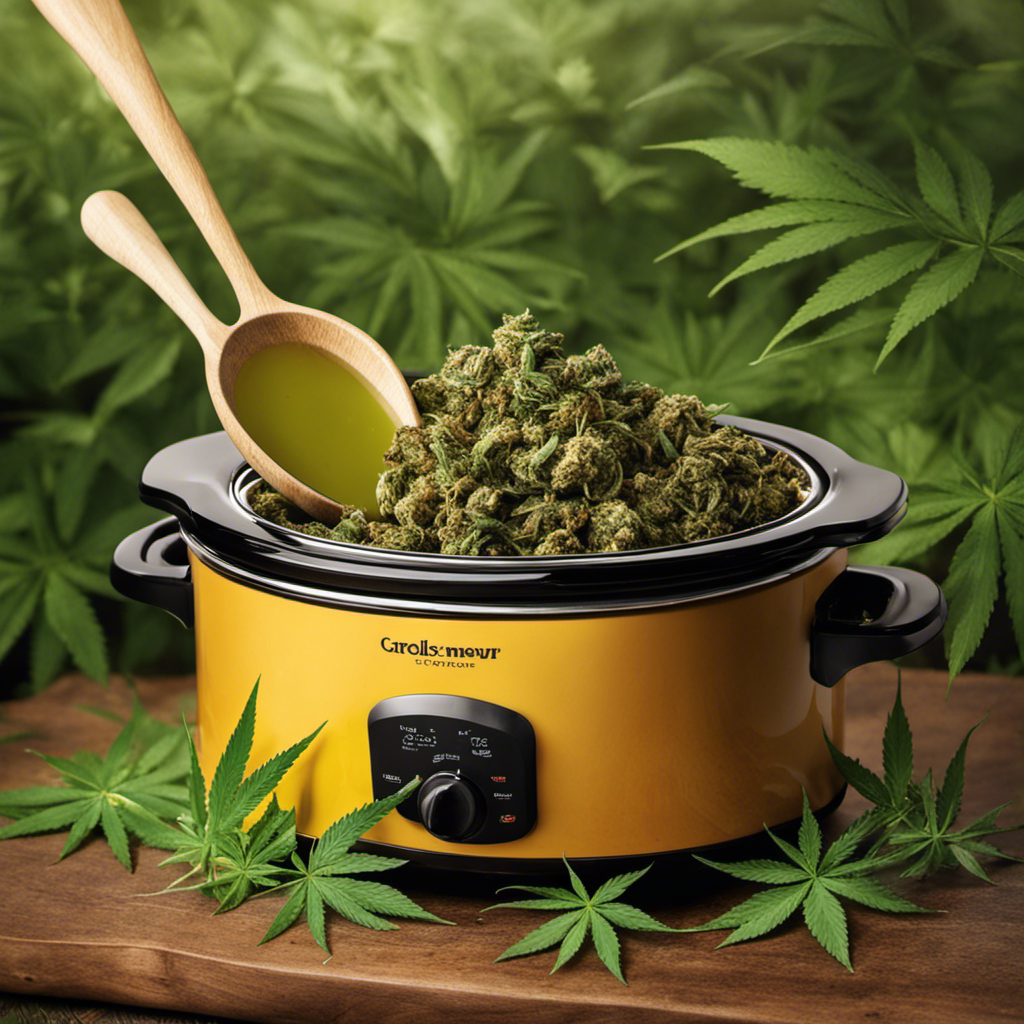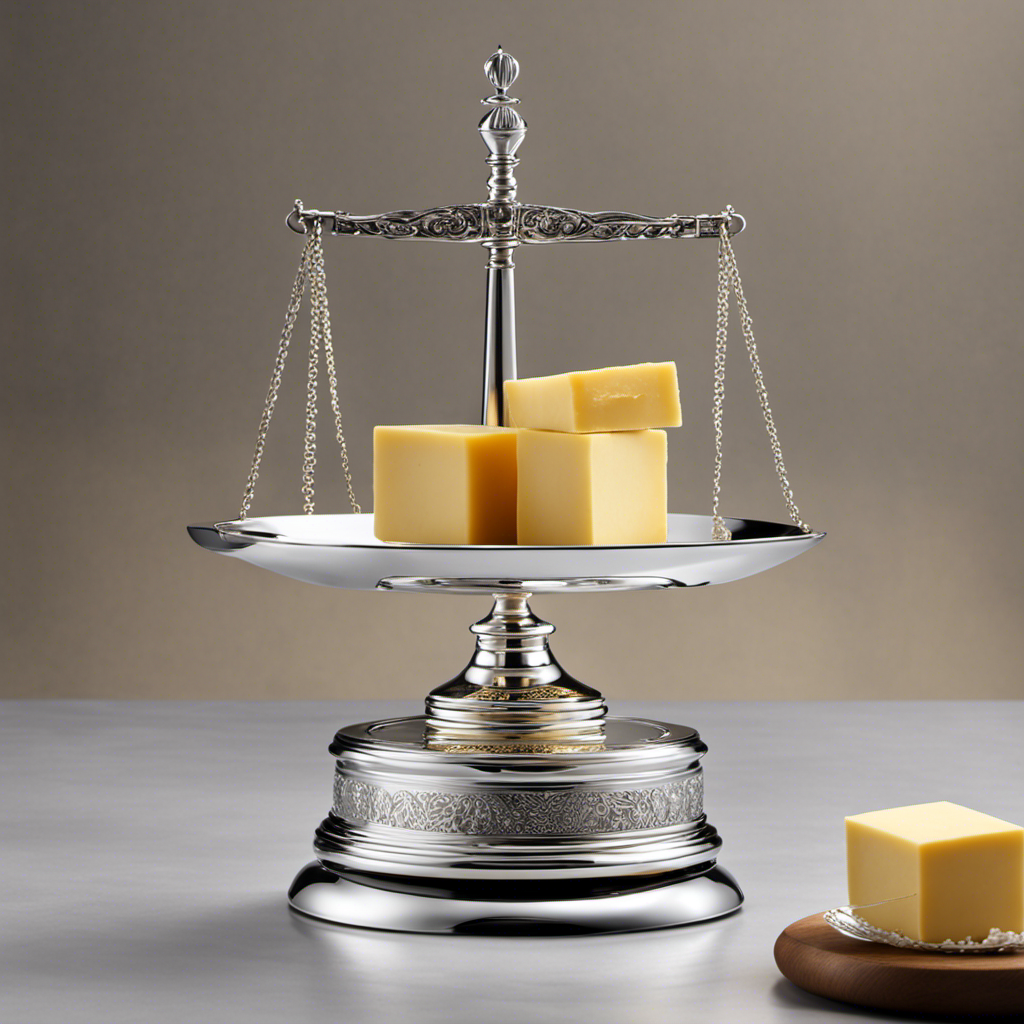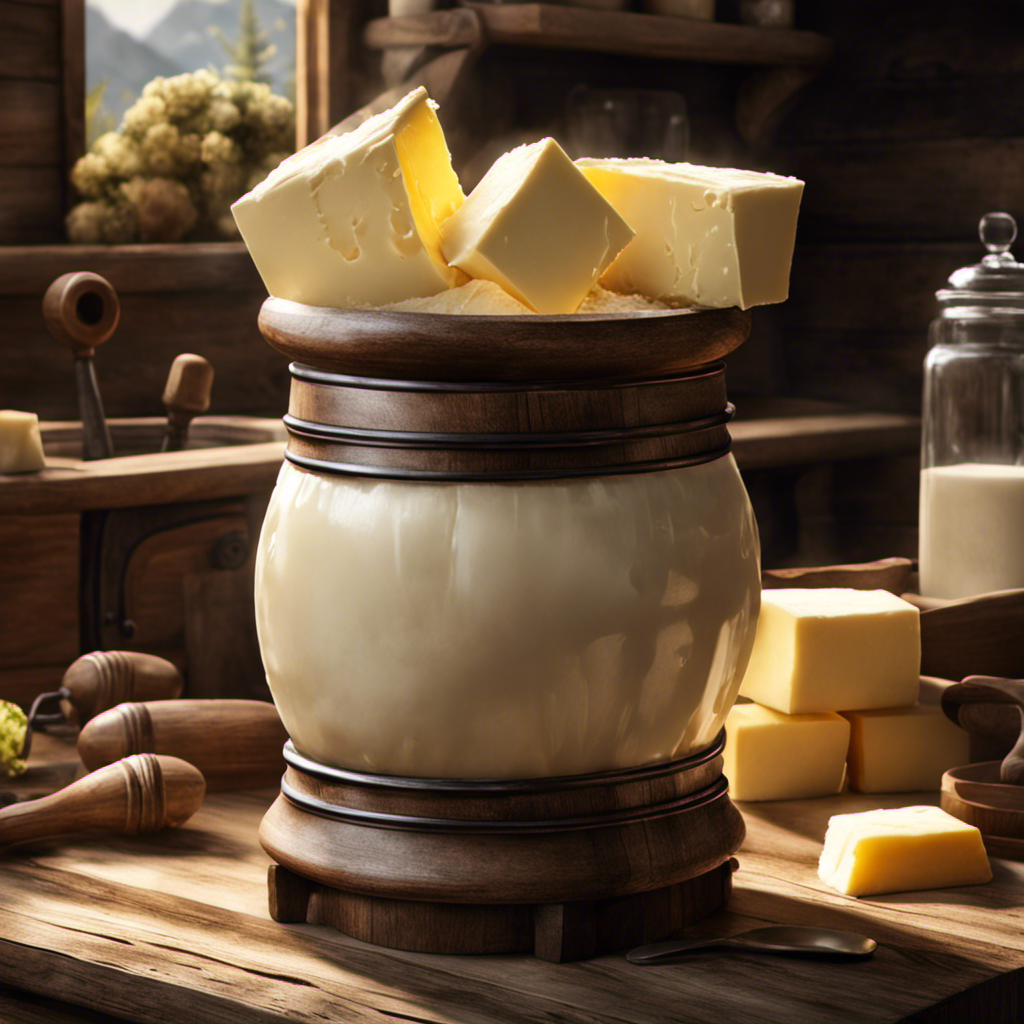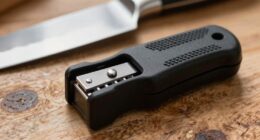Picture the luxurious, velvety texture of homemade unsalted butter. Follow along as I walk you through the steps, and experience the satisfaction of turning cream into this essential ingredient.
With just a few steps, you’ll be able to create a buttery masterpiece that’s perfect for baking, cooking, or spreading on warm toast.
Get ready to immerse yourself in the world of butter-making, and prepare to be amazed by the delicious results.
Let’s dive in and learn how to make unsalted butter together.
Key Takeaways
- Churning the cream breaks down fat globules and releases buttermilk.
- Separating the butter from the buttermilk allows control over salt content and enhances the taste of baked goods.
- Washing and shaping the butter improves texture and removes residual flavors, making it easier to use and adding elegance to dishes.
- Storing unsalted butter in an airtight container in the refrigerator maintains freshness, extends shelf life, and allows for versatile use in cooking and baking.
Gathering the Ingredients
To make unsalted butter, you’ll need heavy cream and a pinch of salt.
Using unsalted butter in baking has several benefits. Firstly, it allows you to have complete control over the salt content in your recipes. This is especially important when baking delicate pastries or cakes where the precise balance of flavors is crucial.
Secondly, unsalted butter has a milder taste, allowing the other ingredients in your baked goods to shine. It also provides a clean and pure butter flavor without any added saltiness.
It’s important to differentiate between unsalted butter and salted butter, as the latter contains added salt, which can affect the overall taste and texture of your baked goods.
Now that we have gathered the ingredients, it’s time to move on to the next step: churning the cream.
Churning the Cream
Start churning the cream until it starts to separate into butter and buttermilk. There are different methods of churning butter, but the most common one involves using a stand mixer or a hand mixer. You can also use a jar or a butter churner if you prefer a more traditional approach.
Churning the cream is an important step in making unsalted butter because it helps break down the fat globules and release the buttermilk. The process typically takes around 10-15 minutes, depending on the speed and intensity of your churning. As you churn, you will notice the cream thickening and eventually separating into solid butter and liquid buttermilk.
The benefits of using unsalted butter in baking are numerous. It allows you to control the amount of salt in your recipes, resulting in a more balanced flavor. Additionally, unsalted butter has a higher fat content, which leads to tender and moist baked goods.
Now that the cream has separated into butter and buttermilk, we can move on to the next step of separating the butter from the buttermilk.
Separating the Butter From the Buttermilk
Now that the butter and buttermilk have separated, you can easily strain the buttermilk from the solid butter. To do this, follow these steps:
- Place a fine-mesh strainer or cheesecloth over a clean container.
- Gently pour the mixture of butter and buttermilk into the strainer, allowing the buttermilk to drain through while keeping the solid butter in the strainer.
- Once the buttermilk has completely drained, you can collect it in a separate container for alternative uses.
Buttermilk, with its tangy flavor and creamy texture, can be used in various recipes. It adds moisture and tenderness to baked goods like pancakes, biscuits, and cakes. It can also be used as a marinade for chicken or as a base for creamy salad dressings.
Unsalted butter, on the other hand, has its own benefits for baking. It allows you to have better control over the salt content in your recipes, especially when you are using other salty ingredients. It also provides a pure, rich flavor that enhances the taste of your baked goods without overpowering other ingredients.
Washing and Shaping the Butter
Washing the butter is an important step in the process of separating the remaining buttermilk from the solid. Once the butter has been churned and the buttermilk has been drained, it is necessary to wash the butter to remove any remaining traces of buttermilk.
To do this, place the butter in a bowl of cold water and gently knead it with your hands. As you knead, you will notice the water becoming cloudy as the buttermilk is released. Drain the water and repeat the process until the water remains clear. This step is crucial because any remaining buttermilk can cause the butter to spoil more quickly.
Additionally, washing the butter helps to improve its texture and remove any residual flavors. Once the butter has been washed, it can be shaped using various techniques, such as rolling it into a log or pressing it into molds. Shaping the butter not only makes it easier to use but also adds a touch of elegance to any dish it is used in.
The benefits of using unsalted butter are numerous. It allows the cook to have complete control over the amount of salt in a recipe, making it ideal for those who are watching their sodium intake. Unsalted butter also has a pure, clean flavor that can enhance the taste of both sweet and savory dishes.
Storing and Using Unsalted Butter
To properly store and use unsalted butter, it is important to keep it in an airtight container in the refrigerator. This will help maintain its freshness and prevent it from absorbing any odors from other foods in the fridge.
Here are a few tips for storing and using unsalted butter:
-
Keep it in an airtight container: This will protect the butter from exposure to air, which can cause it to spoil faster.
-
Store it in the refrigerator: Butter can go rancid if left at room temperature for too long. Keeping it in the fridge will help preserve its quality and extend its shelf life.
-
Use it in cooking and baking: Unsalted butter is versatile and can be used in a variety of recipes. It adds richness and flavor to dishes, and allows you to control the amount of salt in your cooking.
Using unsalted butter has its benefits. It allows you to have more control over the salt content in your food and lets the natural flavors of the ingredients shine through.
Frequently Asked Questions
Can I Use a Blender or Food Processor to Churn the Cream Instead of a Butter Churn?
Yes, you can use a blender or food processor to churn cream instead of a butter churn. The pros are convenience and speed, but the cons are that it may not produce as consistent results as a traditional churn. A stand mixer can also be used for churning butter.
What Is the Difference Between Unsalted Butter and Salted Butter?
The difference between unsalted butter and salted butter lies in the absence or presence of salt. Unsalted butter is preferred in baking as it allows for better control of the salt content in recipes.
Can I Use Pasteurized Cream to Make Unsalted Butter?
Yes, you can use store-bought pasteurized cream to make unsalted butter. While some prefer using raw cream for its flavor, it is not necessary. The process remains the same, resulting in creamy homemade butter.
How Long Will the Unsalted Butter Last in the Refrigerator?
The unsalted butter will last in the refrigerator for about 2-3 weeks. To extend its shelf life, store it in an airtight container. Proper storage tips are crucial to maintain its freshness and prevent spoilage.
Can I Add Flavorings or Herbs to the Butter While Washing and Shaping It?
Yes, you can add flavorings or herbs to unsalted butter while washing and shaping it. It’s a creative way to enhance the taste of homemade unsalted butter and experiment with different flavors.
Conclusion
As I poured the creamy white liquid into the churn, I couldn’t help but feel a sense of transformation. The simple act of churning had turned plain cream into something magical.
With each turn of the handle, the butter began to separate from the buttermilk, like a delicate dance of flavors.
As I washed and shaped the butter, I marveled at its smooth texture and rich aroma.
Finally, as I stored it away, I knew that this unsalted butter would bring a touch of decadence to every dish it graced.
